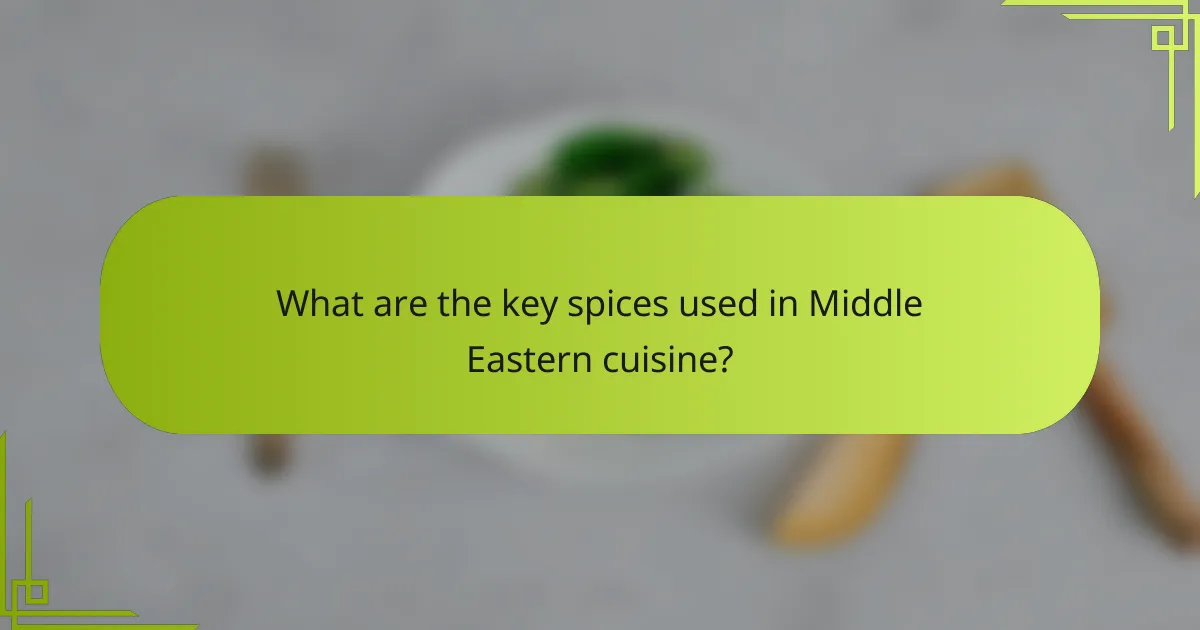Middle Eastern cuisine is a vibrant tapestry of rich spices and diverse dishes that celebrate communal dining. With flavors that range from the savory depth of shawarma to the refreshing zest of tabbouleh, these meals are not just about nourishment but also about bringing people together. The use of fresh ingredients and traditional cooking techniques highlights the region’s culinary heritage, making each dish a unique experience.

What are the best Middle Eastern dishes to try in Canada?
In Canada, some of the best Middle Eastern dishes to try include shawarma, hummus, kebabs, tabbouleh, and baba ganoush. These dishes showcase the rich flavors and communal dining traditions of Middle Eastern cuisine, making them popular choices in many Canadian cities.
Shawarma
Shawarma is a popular Middle Eastern street food made from marinated meat, typically lamb, chicken, or beef, that is slow-cooked on a vertical rotisserie. It is usually served in a pita or flatbread, accompanied by vegetables and sauces like tahini or garlic sauce. In Canada, shawarma can be found in many restaurants and food trucks, often at affordable prices.
When ordering shawarma, consider trying it with a side of pickles or fries for added texture and flavor. Be cautious of portion sizes, as some servings can be quite large, making it easy to share or save for later.
Hummus
Hummus is a creamy dip made primarily from blended chickpeas, tahini, olive oil, lemon juice, and garlic. It is a staple in Middle Eastern cuisine and is often served as an appetizer or side dish. In Canada, hummus is widely available in grocery stores and restaurants, with many variations including roasted red pepper or spicy harissa.
For a delightful experience, pair hummus with fresh pita bread, vegetables, or even as a spread on sandwiches. When purchasing pre-made hummus, check the ingredient list for quality and authenticity, as some brands may include preservatives or artificial flavors.
Kebabs
Kebabs consist of skewered and grilled meat, often marinated with spices and herbs, making them a flavorful option in Middle Eastern cuisine. Common types include shish kebabs (chunks of meat) and kofta kebabs (ground meat mixed with spices). In Canada, kebabs are frequently found at Middle Eastern restaurants and barbecues.
When enjoying kebabs, consider trying them with a side of rice or a fresh salad. If grilling at home, marinate the meat for several hours to enhance the flavor and tenderness.
Tabbouleh
Tabbouleh is a refreshing salad made primarily from finely chopped parsley, tomatoes, mint, onion, and bulgur wheat, dressed with olive oil and lemon juice. This dish is known for its vibrant flavors and is often served as a side dish or appetizer. In Canada, tabbouleh is a popular choice for those seeking a healthy and light option.
To enjoy tabbouleh at its best, serve it chilled and allow the flavors to meld for a few hours before serving. Be mindful of the bulgur wheat ratio, as too much can overpower the fresh herbs.
Baba Ganoush
Baba ganoush is a smoky eggplant dip made by roasting eggplants and blending them with tahini, garlic, lemon juice, and olive oil. This creamy dip is a favorite in Middle Eastern cuisine and is often served alongside pita bread or fresh vegetables. In Canada, baba ganoush can be found in many Middle Eastern restaurants and grocery stores.
For a unique twist, try adding spices like cumin or smoked paprika to enhance the flavor. When making baba ganoush at home, ensure the eggplants are well-roasted to achieve that signature smoky taste.

How to prepare authentic Middle Eastern meals?
Preparing authentic Middle Eastern meals involves using rich spices, fresh ingredients, and traditional cooking techniques. Focus on communal dining experiences and diverse dishes that reflect the region’s culinary heritage.
Spice blending techniques
Spice blending is essential in Middle Eastern cuisine, as it creates the unique flavors that define many dishes. Common spices include cumin, coriander, cardamom, and sumac, which can be mixed in varying proportions to suit personal taste.
To create a balanced blend, start with a base of warm spices like cinnamon and nutmeg, then add herbal notes from dried mint or thyme. Experiment with ratios, but a common starting point is equal parts of the primary spices, adjusting based on your preference.
Cooking methods for rice dishes
Rice is a staple in Middle Eastern meals, often cooked using methods like pilaf or steaming. For pilaf, sauté the rice in oil or butter before adding broth, which enhances flavor and texture.
When steaming, ensure the rice is rinsed to remove excess starch, resulting in fluffier grains. A common ratio is one part rice to two parts water, but this may vary depending on the rice type.
Marinating meats
Marinating meats is crucial for infusing flavor and tenderness in Middle Eastern dishes. A typical marinade includes yogurt, lemon juice, garlic, and a mix of spices, allowing the meat to absorb the flavors over several hours or overnight.
For best results, use cuts like chicken thighs or lamb shoulder, which benefit from longer marination. Avoid over-marinating, as acidic ingredients can break down the meat too much, leading to a mushy texture.

What are the health benefits of Middle Eastern spices?
Middle Eastern spices offer numerous health benefits, primarily due to their anti-inflammatory, antioxidant, and digestive health properties. Incorporating these spices into meals can enhance overall well-being and support various bodily functions.
Anti-inflammatory properties
Many Middle Eastern spices, such as turmeric and cumin, are known for their strong anti-inflammatory effects. These spices can help reduce inflammation in the body, which is linked to various chronic diseases, including heart disease and arthritis.
Using spices like ginger and cinnamon in your cooking can provide additional anti-inflammatory benefits. Aim to include a variety of these spices in your daily meals to maximize their health effects.
Rich in antioxidants
Middle Eastern spices are packed with antioxidants, which help combat oxidative stress and protect cells from damage. Spices like sumac and saffron are particularly high in these beneficial compounds.
Incorporating a mix of spices into your diet can enhance your antioxidant intake. Consider adding spices to salads, stews, and marinades to boost flavor and health benefits simultaneously.
Digestive health support
Spices such as coriander and fennel are known to support digestive health by promoting healthy gut function and reducing bloating. These spices can stimulate digestion and help alleviate discomfort after meals.
To improve digestion, try using these spices in your cooking or as part of herbal teas. Regular consumption can lead to better digestive health and overall comfort.

How to host a Middle Eastern communal meal?
Hosting a Middle Eastern communal meal involves creating a welcoming atmosphere and serving a variety of dishes that encourage sharing. Emphasizing rich flavors and communal dining traditions enhances the experience for all guests.
Setting up the dining space
Create a comfortable and inviting dining area, ideally with low seating and cushions to encourage relaxation. Use a large table or spread a clean tablecloth on the floor to accommodate shared dishes.
Consider adding decorative elements such as colorful tableware, candles, and traditional textiles to enhance the ambiance. Soft lighting and music can also contribute to a warm atmosphere.
Choosing dishes for sharing
Select a variety of dishes that represent the diverse flavors of Middle Eastern cuisine. Popular options include hummus, tabbouleh, falafel, and grilled meats, which can be served alongside rice or flatbreads.
Aim for a balance of vegetarian and meat options, ensuring there are enough dishes to satisfy all guests. A good rule of thumb is to prepare at least three to five different dishes for a small gathering, increasing the variety for larger groups.
Traditional serving customs
In Middle Eastern culture, meals are often served family-style, with dishes placed in the center for everyone to share. Guests typically use bread to scoop up food, so provide ample pita or lavash for this purpose.
Encourage guests to serve themselves and try a bit of everything. It’s customary to offer food multiple times, allowing guests to refill their plates as desired. Remember to respect dietary restrictions and preferences when planning your menu.

What are the key spices used in Middle Eastern cuisine?
Middle Eastern cuisine is characterized by a rich array of spices that enhance the flavors of its diverse dishes. Key spices include cumin, coriander, sumac, and za’atar, each contributing unique tastes and aromas that define this culinary tradition.
Cumin
Cumin is a staple spice in Middle Eastern cooking, known for its warm, earthy flavor. It is often used in spice blends and is a key ingredient in dishes like falafel and shawarma.
When using cumin, consider toasting the seeds lightly to release their essential oils, which intensifies their flavor. Ground cumin is also widely available and can be used in a variety of recipes, but fresh ground is generally more aromatic.
Coriander
Coriander, with its citrusy and slightly sweet flavor, complements many Middle Eastern dishes. Both the seeds and fresh leaves (cilantro) are used, providing versatility in cooking.
In spice blends, coriander seeds are often combined with cumin for a balanced flavor profile. Fresh coriander leaves can be added as a garnish to enhance the freshness of salads and dips.
Sumac
Sumac is a tangy spice that adds a unique sourness to Middle Eastern cuisine. It is commonly sprinkled over salads, grilled meats, and rice dishes, providing a refreshing contrast to rich flavors.
When using sumac, a little goes a long way, so start with a small amount and adjust to taste. It can also be mixed with olive oil to create a flavorful dressing or marinade.
Za’atar
Za’atar is a popular spice blend that typically includes thyme, oregano, marjoram, sesame seeds, and sumac. This mix is often used as a seasoning for bread, meats, and vegetables.
Za’atar can be used in various ways, such as mixing it with olive oil for dipping or sprinkling it over roasted vegetables. Its versatility makes it a favorite in many Middle Eastern households, adding depth and flavor to a wide range of dishes.

How to select the best Middle Eastern restaurants in Canada?
Selecting the best Middle Eastern restaurants in Canada involves considering authenticity, menu variety, and customer reviews. Look for establishments that emphasize traditional dishes and use high-quality ingredients to ensure an enjoyable dining experience.
Consider Authenticity
Authenticity is key when choosing a Middle Eastern restaurant. Look for places that showcase traditional cooking methods and recipes passed down through generations. Restaurants that source ingredients from local Middle Eastern markets often provide a more genuine experience.
Menu Variety
A diverse menu is essential for a satisfying Middle Eastern dining experience. Seek out restaurants that offer a wide range of dishes, including mezze, grilled meats, and vegetarian options. This variety allows you to explore different flavors and textures typical of Middle Eastern cuisine.
Check Customer Reviews
Customer reviews can provide valuable insights into the quality of food and service at a restaurant. Websites like Yelp or Google Reviews can help you gauge the overall dining experience. Pay attention to comments about specific dishes and the authenticity of the flavors.
Look for Communal Dining Options
Many Middle Eastern restaurants offer communal dining experiences, which enhance the enjoyment of the meal. Look for places that encourage sharing dishes among diners, as this reflects the cultural significance of communal meals in Middle Eastern traditions.
Evaluate Price Points
Price can vary widely among Middle Eastern restaurants in Canada. While some establishments may offer affordable options, others may be more upscale. Consider your budget and look for restaurants that provide good value for the quality of food and service offered.










